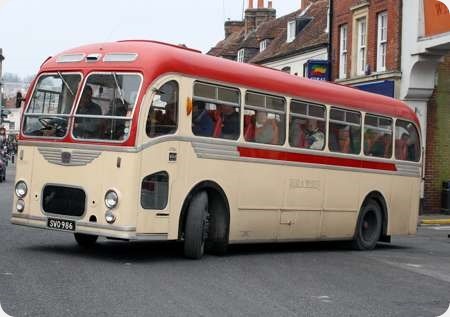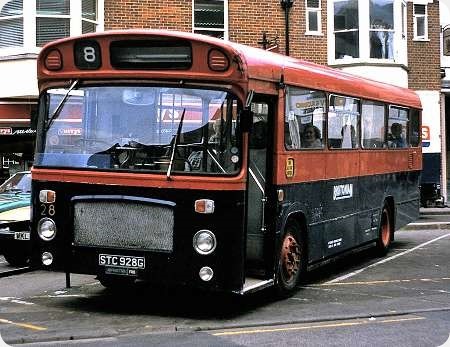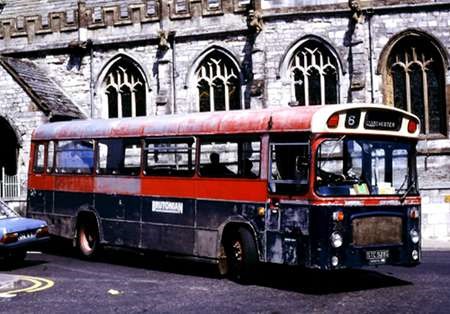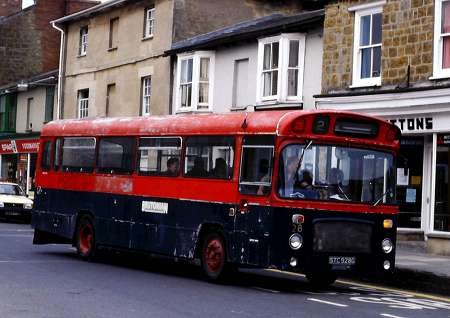Southampton Corporation – AEC Regent V – KOW 909F – 401
Southampton Corporation
1967
AEC Regent V 3D2RA
Neepsend H40/30R
KOW 909F was in the last batch of AEC Regents delivered to Southampton, in 1967. It is of the 3D2RA variety and the body was built by Neepsend, to the H70R formation. It was decorated in the early 1980s as being the Transport Department’s last rear entry bus, but then came Deregulation and it was returned to service. In this view, it is in Highfield Lane, on a special running day to mark the closure of Portswood Depot. It’s 30 May 2010.
Photograph and Copy contributed by Pete Davies
27/02/17 – 07:54
When all the perfect ingredients come together you get the perfect end result as in this case, having the best chassis of it’s type with elegant well balanced bodywork finished with a simple and tasteful livery, to me proves the point. All that is missing, understandably are the sound effects of the AV691 engine and the Monocontrol gearbox the thought of which brings me over all nostalgic.
AAAh happy days.
Diesel Dave
27/02/17 – 16:000
Glad you liked it, Dave!
Pete Davies
27/02/17 – 16:02
I could not agree more with Diesel Dave, with one exception. Who came up with the idea of those front indicators above the mirror line. I can see the logic of not reflecting in the mirrors, but those particular light units were the same as Duple fitted on later model Super Vegas (I think) – one on the side & one on the lower front corner. They were not very efficient on the coach, & next to useless on the Regent V on a sunny day (we used to get those in Southampton, don’t know about now though!)
David Field
27/02/17 – 16:46
Those indicators worked on my Dinky VAL!
Joe
28/02/17 – 16:37
The reason I asked was that, Southampton being quite conservative (small c) in it’s view to change (Late model Arab III’s, etc), it seemed an odd thing to do when the rest of the fleet (Arab III’s, Arab UF, PD2, PD2A, Regent V) were fitted with a different type of side indicator, mounted at waist height, just behind the cab door. These lights were quite ornate in shape, and had been used since the first buses were fitted with flashers (on the front only as I recall). I think they might have been made by Rubbolite, they were the same as fitted to Dodge 500 series trucks. I can imagine the Stores having boxes of these in stock, looking up at the new buses & saying "there goes the budget"!! I think the next change must have been to the teardrop shape Lucas flashers on the Atlanteans.
David Field
01/03/17 – 06:35
Comparing this with a photo of an earlier example, I notice that an emergency window has appeared immediately aft of the cab. It could be that the relocation of the flasher from that position had something to do with that. Alternatively it might just have been a a belief that the flashers would be more noticeable on the front of the bus than at the side, possibly following some sort of incident. And of course nobody would have known that they were going to be useless on a sunny day when they ordered them from the catalogue!
Peter Williamson
01/03/17 – 06:36
The indicators were one of two versions offered by East Lancs/Neepsend at the time. The other type was fitted at the same height but on short arms protruding from the body with round orange plastic covers so the indicator could be seen from both front and rear. An exception were Reading’s East Lancs bodied Lolines which had the traditional side indicators fitted on the very front of the between decks panels.
Phil Blinkhorn
02/03/17 – 07:11
The comments about the type and positioning of the front indicators reminds me that Eastbourne Corporation’s two batches of PD2’s had different types, the 1966 batch No’s 71-80 BJK 671-680D had two a teardrop shaped fitted at lower deck window level behind the cab door and a round flat lense mounted on a shaped housing low on the front wing, the latter looking something of an afterthought. The second batch No’s 81-85 DHC 781-785E had the same type of high mounted type as the Southampton Regents I don’t recall any problems with them.
Diesel Dave
21/12/17 – 11:40
I remember the Ramsbottom East Lancs PD3s had that arrangement of flashing indicators.
David Pomfret






